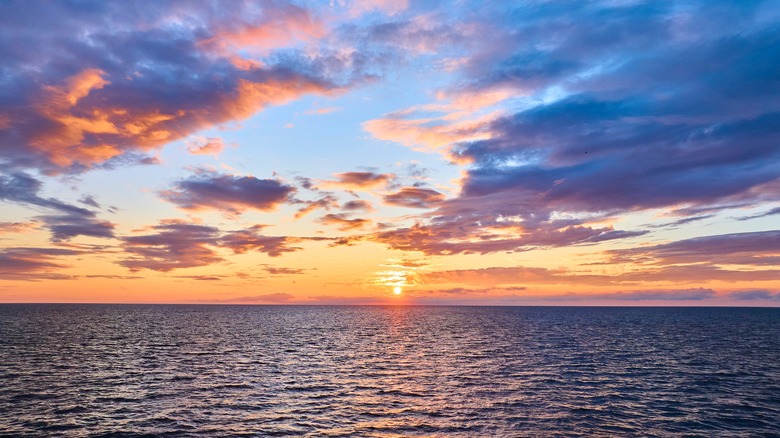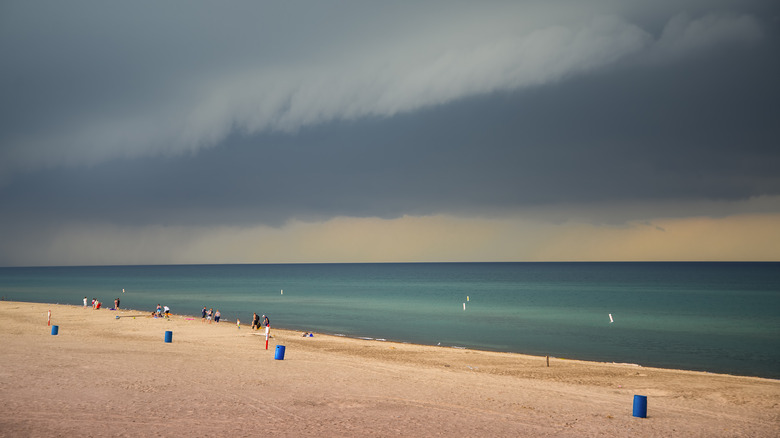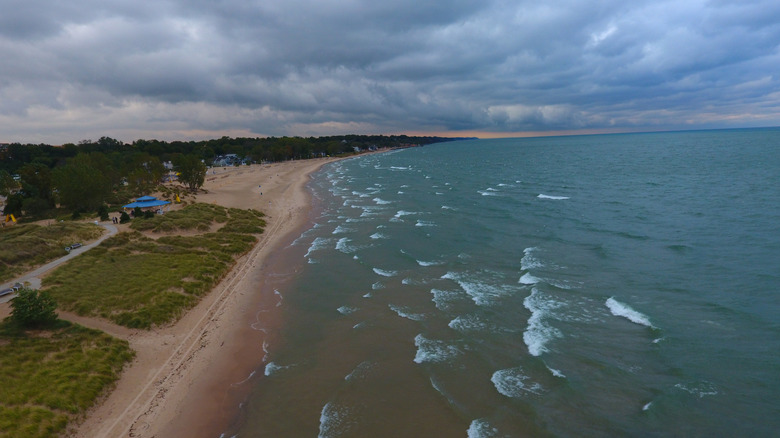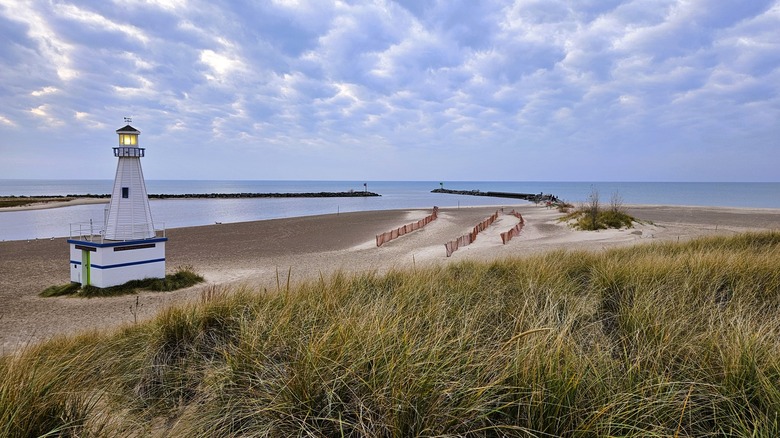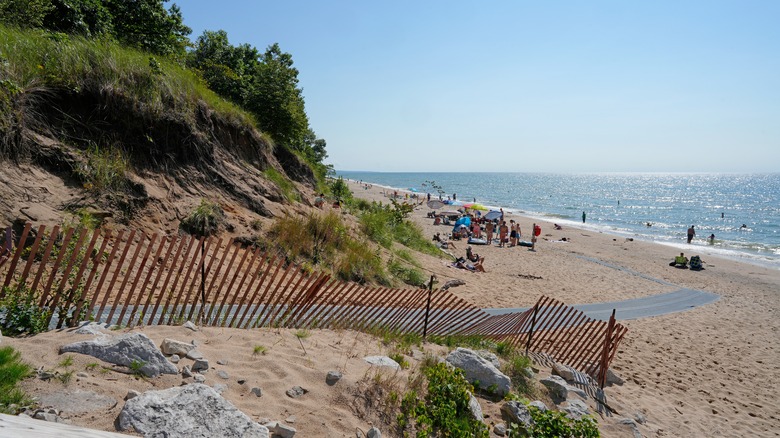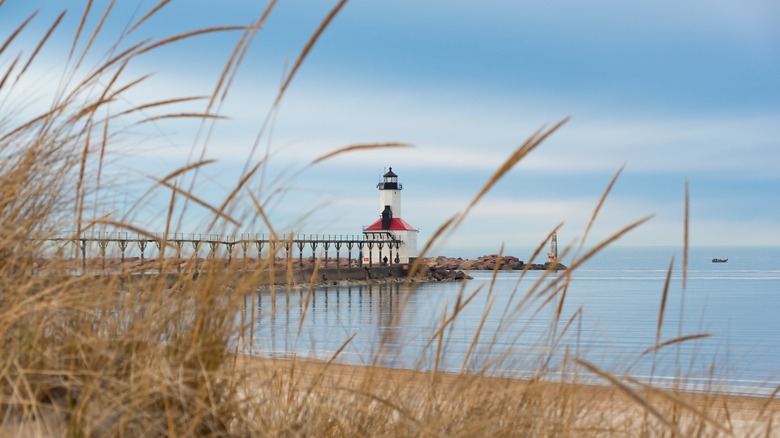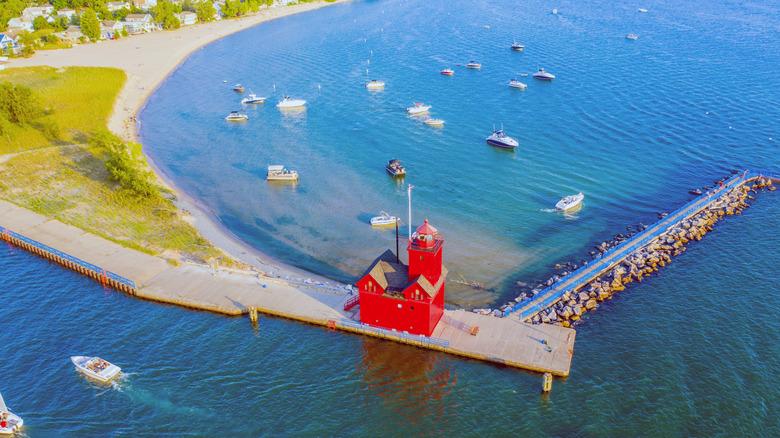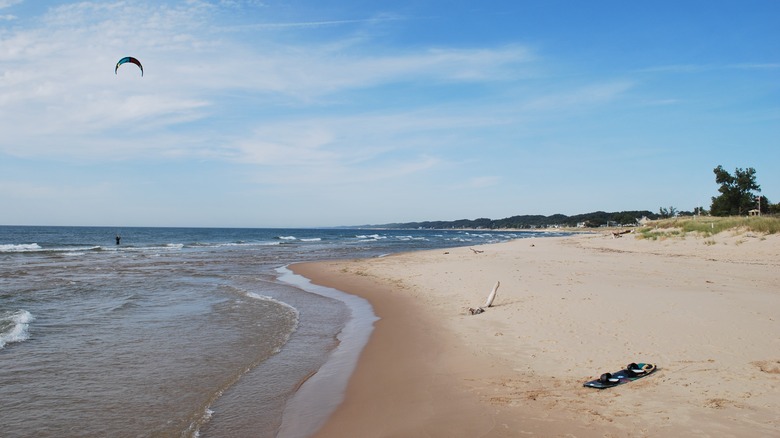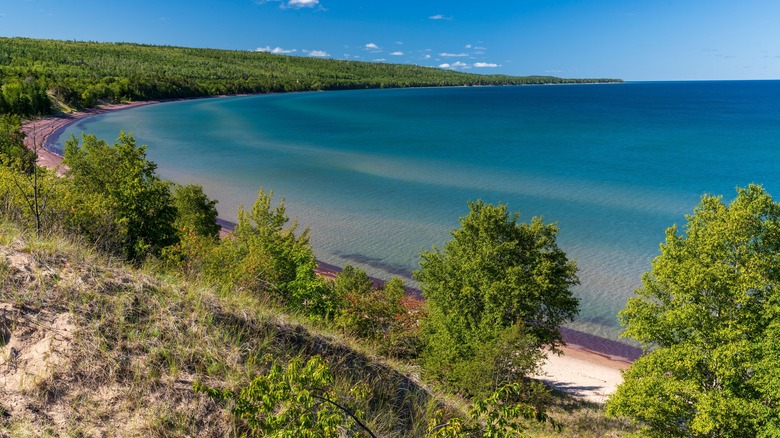The Most Dangerous Beaches On Lake Michigan's Shores, According To Research
Have you been thinking of taking a dip in Lake Michigan? We can't blame you. After all, the only Great Lake that sits entirely within the United States is a truly spectacular destination, but you might want to pause before jumping in. Although this spot may sound like the perfect place to enjoy a day out with friends and family, enjoying the sunset views and jet skiing into the horizon, research shows that Lake Michigan is actually home to some of the most dangerous beaches in America.
The beaches along the lake's shoreline have some shockingly high fatality rates, the South Bend Tribune reports. With very few lifeguards employed to guard the beaches nestled along Lake Michigan's shores, the last 15 years have seen 640 lives lost thanks to these unstable waters. Even some of the strongest swimmers are at risk of being caught by this dark-horse danger. This is due to a combination of unpredictable weather, strong rip currents, and shoreline structures like break walls and piers that affect the water's natural currents, and thus increase the risk of injury to unsuspecting swimmers. Lake Michigan is beautiful, but it can also be deadly.
Though swimming in Lake Michigan is not always fatal, it's important to know which beaches pose the most significant threats. Drowning or injury are not the only threats at play, either. Aside from the potentially life-threatening currents, some beaches on this iconic lake's shores suffer from poor water quality and high levels of bacteria due to stormwater runoff. So, both inside and out, vacationers must protect themselves as they set sail on this third-largest of America's five Great Lakes. Cross out these eight beaches on your map and you'll be able to enjoy your summer vacation without fear.
Warren Dunes State Park: Sawyer, Michigan
With its enormous dunes that rise 240 feet above water level, Warren Dunes State Park might look like the perfect combination of adventure and sandy vistas. Hikers often flock to this state park due to its 6 miles of hiking trails, fit with modern campsites that come with flushing toilets and showers. On first glance, it seems to have it all. However, if you're looking for a place to swim, you might want to think again.
The beach at Warren Dunes State Park is surprisingly dangerous. With the threat of powerful currents always lurking and limited lifeguard presence, you would do well not to wade in too deep here. The rip currents often seen in this corner of Lake Michigan are formed when waves repeatedly break over sandbars, thus creating a deepened water channel that causes water to flow back into the ocean in strong and fast waves. In August of 2023, a 38-year-old Illinois local was taken in by Warren Dunes' dangerous waters and became the second drowning victim of that year (as reported by WWMT).
Even if you don't get into the water, you might find yourself itching and angry after a visit to these dunes. This is because swarms of aggressive biting flies are known to take over the beach area in the early summer months. One visitor who spoke with local news channel WNDU said, "We went right down to the beach front, and immediately we just got swarmed. arms, legs, we've got a golden retriever, she was completely covered head to toe." That isn't anybody's idea of summer fun.
Silver Beach: St. Joseph, Michigan
On the surface, Silver Beach in St. Joseph is a dream for young families looking to enjoy the summer sun in the Wolverine State. Beachgoers have access to sand volleyball courts, a splash pad, and a children's playground, making it perfect for family days out. There is also the South Pier and historic lighthouse, where visitors can stroll along and take postcard-perfect photos, and the Silver Beach Carousel that offers a fun and nostalgic ride for vacationers of all ages.
In fact, the town of St. Joseph is one of the most stunning cities along Lake Michigan's shores, but visitors may want to stay out of the water, given the rip currents that are known to take over this area of the Great Lake. Life jackets have been recommended to people who are visiting Silver Beach on rip current days, as these dangerous currents can pull unsuspecting swimmers far out from shore, making it impossible to swim safely to land. Tall waves can also reach heights of up to 3 to 6 feet. While lifeguards are employed to patrol the beach, red flag days see them patrolling the beach for the sole purpose of keeping people out of the water.
The water can also get so cold that those who brave the waves put themselves at risk of hypothermia. The freezing temperatures can last through summer and are caused by a phenomenon called upwelling, where the northerly winds push warm water away from the shoreline, making way for the cold underbelly.
New Buffalo Beach: New Buffalo, Michigan
New Buffalo Beach in Michigan is rife with boating opportunities and fishing spots, and has also been known to attract avid paddleboarders and kayakers. The break wall running through the water offers visitors a chance to see the clear, breathtaking water up close without getting wet. However, this same break wall is what often causes unpredictable structural currents that pull surprised swimmers far away from the shoreline. Unlike naturally occurring currents, structural currents occur when artificial features disrupt the natural wave patterns.
In July 2025, nine people found themselves caught in a deadly structural current while swimming off the coast of New Buffalo Beach, but thankfully, they were all rescued and brought to safety (as reported by WNDU). Beach erosion on New Buffalo Beach has also reached an all-time high. Several homes have been destroyed due to shifting sands and rising water levels, with city officials fearing that the unstable condition of the beach will push down tourist numbers.
Despite all the negatives, though, New Buffalo Beach is constantly under the watchful eyes of lifeguards, helping to make sure no one is put at risk by dangerous currents or other deadly beach factors. When the water is too dangerous, the beach will be marked with red flags to deter visitors from jumping in. If you do dare to venture in during red flag conditions, you can expect to pay a minimum fine of $500. So make sure you stay out of the water if you see red flags!
Pere Marquette Park: Muskegon, Michigan
Muskegon is a charming waterfront Michigan city with sugar-sand beaches and vintage trolleys. But that's not all; it's also home to Pere Marquette Park, an expansive beach area with volleyball courts, picnic areas, and a 200-foot-long accessible walking path that offers breathtaking views of Lake Michigan's waters. All in all? No one would blame you for choosing this town as your vacation destination. There is plenty to love in Lumbertown.
However, if you do journey to Muskegon, you should be aware of the dangers of its beaches. The waters at Pere Marquette Park are often the site of dangerous currents and high winds. And if these factors weren't treacherous enough on their own, together, the currents and winds frequently produce towering waves that threaten the lives of swimmers.
In 2013, a teenage girl drowned off the coast of the park after being spotted 100 yards offshore, fighting back against the waves. In that same year, swimmers who found themselves unknowingly going for a dip during red flag conditions told a reporter at Michigan Live that "they didn't see a sign of any sort at the park warning them of water conditions." Although not every day at Pere Marquette Park calls for a red flag to be hoisted, prospective beachgoers need to be aware that conditions can quickly turn deadly, and you might not always hear news of the vicious currents or big waves coming your way. Feel free to book your dreamy holiday to Muskegon, but come prepared with a life jacket.
South Haven Beach: South Haven, Michigan
The city of South Haven, nestled on Lake Michigan's shoreline, has been called the "Catskills of the Midwest." And with its sunny beaches and eclectic activities, such as biking trails, vineyards, and kayaking, one can see why. However, if you're planning a trip to this lighthouse-dotted hotspot, it's best that you take extra safety precautions when swimming at South Haven Beach.
A deadly mixture of structure, rip, and longshore currents, high waves, and strong winds all come together to create some very vicious swimming conditions. Even for the strongest of swimmers who may think themselves ready to tackle tougher conditions, South Haven Beach may prove to be a problem. The culprits are the piers located on both the South and North beaches. The structures interrupt the natural flow of Lake Michigan, producing the treacherous conditions.
This certainly isn't helped by the lack of lifeguards on site, which increases the risk of injury or even death for unsuspecting swimmers. The last time lifeguards patrolled the coasts of the beach was in 2001. This has been a constant source of worry for the residents and visitors of South Haven Beach, especially following the deaths of 19-year-old Emily MacDonald and her 22-year-old boyfriend, Kory Ernster, in 2022. Their wrongful deaths have sparked a quiet resilience against this no-lifeguard policy, and while a local campaign resulted in the installation of two lifesaving robots on the beach's shores, the danger of South Haven Beach has not been entirely eliminated.
Washington Park Beach: Michigan City, Indiana
Indiana's wildly underrated beach town of Michigan City is a National Park gateway full of dunes and shopping. Still, while the lakeside vistas may be pretty to look at, they can be unpredictable when it comes to swimming safety. Washington Park Beach, located in Michigan City, is one of the most dangerous beaches on Lake Michigan's shores.
The beach's shore suffers from unpredictable conditions with its strong waves, cold waters, and rip currents often putting swimmers, surfers, kayakers, and more at risk. Like many spots along Lake Michigan's shores, it is the break wall running through the water that is to blame for many of the area's erratic currents. Regardless of the root cause, swimming in these waters can be lethal if done in the wrong weather conditions or if the swimmer isn't prepared for such fierce waves.
Though what might really put you off from venturing into this beach's waters is the risk of E. coli contamination. Researchers have reported unusually high levels of E. coli in the Indiana Dunes area — the same coastal strip where Washington Park Beach is located. Fecal matter found in the water was identified as the root cause of these dangerously high E. coli readings, with the authors of the study (available on PubMed Central) citing its presence as "ubiquitous and persistent." So, even if rip currents aren't enough to scare you off, maybe these health concerns will convince you to steer clear of the crashing waves of this beach.
Holland State Park: Holland, Michigan
Located in Michigan, Holland State Park may look welcoming with its iconic "Big Red" lighthouse that shines out from the end of the pier, and its famously beautiful sunsets that paint the ocean's surface with oranges and pinks. It is an undeniably picturesque setting. However, after doing some research into the beach's safety record, you might have second thoughts about cannonballing into the water.
The waves at Holland State Park can reach towering heights of up to seven feet, and the northerly winds that shake visitors' beach umbrellas have historically reached up to 35 mph. On especially turbulent days, the walkways and piers that were originally installed to make Lake Michigan's beaches more accessible become so drenched in lake water that they, too, should remain off limits. That's not all, as strong currents have also been known to drag swimmers far away from shore.
Many drownings have occurred at Holland State Park due to these conditions. In 2020, the summer season had an inauspicious start when two swimmers lost their lives on the same day. It's believed that rip currents were to blame, and even those swimmers who consider themselves highly skilled are advised to keep themselves in the loop regarding the wild, unstable waters. These dangerous currents can crop up with little warning, and it is important that swimmers (or anyone else in the water) vacate the waves immediately when a red flag is raised. Weaker swimmers should remain on shore even in yellow flag conditions, as danger is still present.
Grand Haven State Park: Grand Haven, Michigan
Grand Haven is a charming Midwest lakeside resort city that offers serene beaches, a bustling boardwalk, and lively events like the Music on the Grand concert series and a kite festival. But while the Grand Haven State Park pier is the site of many community gatherings, it is also the reason why this beach makes the list for one of the most dangerous on Lake Michigan's shores. As an artificial structure planted in the middle of an already tempestuous lake, the Grand Haven pier has been known to cause washing machine-like currents that whip up unwitting swimmers. These choppy water conditions, combined with intense Midwest winds that contribute to the water's freezing, ice-like temperatures, massively increase the risk of harm for anyone brave enough to take a dip.
With unpredictable waters and no lifeguard system in place, the beach at Grand Haven State Park sadly has a long history of drownings and near-accidents. To combat this, safety towers were installed along the shores in 2024 that contain a flotation device to help keep struggling swimmers afloat and a button that will immediately alert and activate an emergency response in order to rescue swimmers as quickly as possible. While this is a step forward in rehabilitating Grand Haven's beach, it also highlights the danger posed by this corner of Lake Michigan. To avoid finding yourself in a sticky situation altogether, it would be best to simply enjoy the boardwalk sights and the artsy atmosphere without tackling the waters.
Methodology
To determine the most dangerous beaches in the Lake Michigan area, we turned to a variety of sources that highlight safety concerns along the shoreline. First, we reviewed official state and government websites — particularly those from Michigan and Indiana — that have documented hazardous swimming conditions such as strong rip currents, disruptive piers and break walls, and high winds that can easily catch swimmers off guard. We also paid close attention to warnings about environmental dangers like insects and E. coli, which can easily turn a beach day into a not-so-fun experience.
In addition to government data, we combed through local news outlets around the lake for reports of drownings, rescues, and other water-related emergencies. These stories helped us better understand which specific beaches have a consistent track record of danger, beyond just the occasional fluke incident. Lastly, we paid close attention to what each beach has been doing to mitigate these incidents; are there lifeguards on duty? Is there a flag system in place? In areas where no such apparatus is available or has just recently been installed, emergencies are more likely to crop up. When trouble turns up, help is always appreciated.
By cross-referencing these sources, we were able to compile a list of beaches that have developed a reputation for being high-risk. While Lake Michigan is home to several dream vacation spots, these eight beaches serve as a reminder that even inland shores can demand serious respect. If you're a tourist or a casual swimmer, these are the spots you'll want to approach with extra caution.
